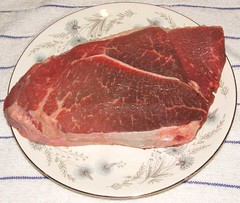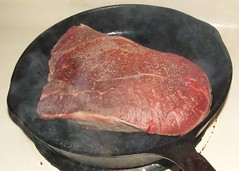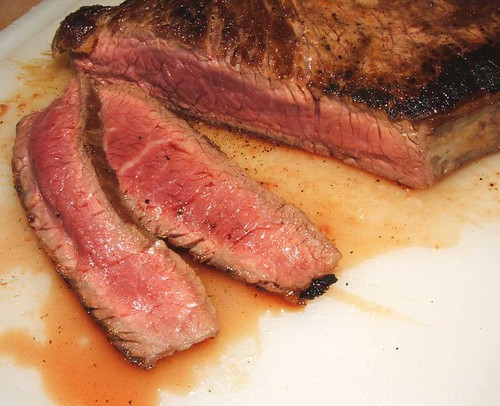Maillard Reaction (supper too)
Wednesday, September 14, 2005
Today we are learning about the Maillard reaction. This is a chemical reaction that develops the flavor in roast meat and also in other foods:- 'caramel' made from milk and sugar
- the browning of bread and toast
- the colour of beer, chocolate, coffee, and maple syrup
- the color of dried or condensed milk
yikes it also is what happens to your skin when you use self-tanning lotions (good thing we have never used that stuff!)
We got the following from The Free Dictionary online.
The Freedictionary.com - Maillard reaction
The Maillard reaction is a chemical reaction between an amino acid and a reducing sugar, usually requiring the addition of heat. Like caramelization, it is a form of non-enzymatic browning. The reactive carbonyl group of the sugar interacts with the nucleophilic amino group of the amino acid, and interesting but poorly characterized odor and flavor molecules result. This reaction is the basis of the flavoring industry, since the type of amino acid determines the resulting flavor.
In the process, hundreds of different flavor compounds are created. These compounds in turn break down to form yet more new flavor compounds, and so on. Each type of food has a very distinctive set of flavor compounds that are formed during the Maillard reaction. It is these same compounds that flavor scientists have used over the years to create artificial flavors.
Although used since ancient times, the reaction is named after the chemist Louis-Camille Maillard who investigated it in the 20th century.
The process
1. The carbonyl group of the sugar reacts with the amino group of the amino acid, producing N-substituted glycosylamine and water
2. The unstable glycosylamine undergoes Amadori rearrangement, forming ketosamines
3. There are several ways for the ketosamines to react further:
4. * Produce 2 water and reductones
5. * Diacetyl, acetol, pyruvaldehyde and other short-chain hydrolytic fission products can be formed
6. * Produce brown nitrogenous polymers and melanoidins
Do another kind of experiment with info from this site:
Maillard Reaction info
Directions for performing the Maillard Reaction on a London Broil Steak:
1) Bring up to room temperature.
2) Heavily salt the bottom of an un-oiled WELL seasoned cast iron pan and heat to medium high (turn on the vents in your kitchen hood and also open windows if you can).
3) Once the pan is up to heat, put the steak in and sear for about 7 minutes.
4) Keep an eye out for excessive burning.
5) Pick up the steak, add more salt and then flip the steak over, back into the pan to cook the other side.
6) Sear for about 5 minutes, watching for char, until this side is well singed.
7) Remove from heat and allow to rest about 10 minutes (as long as you can stand it!)
8) Slice against the grain, serve, and enjoy!
Raw London Broil, make sure to pat it dry.

Sear the steak, watching for char.

Remove and let rest to reabsorb juices. Slice against the grain, enjoy!

Notes:
Looking at the darker parts on the right - This is a reactant product but since it has gone on to a deeper color it likely has produced more complex breakdown products, some of which have been implicated in carcinogenesis.
Looking at the rest of the meat, at the cooked edges - The region that is cooked and beginning to develop color is experiencing the Maillard Reaction. A london broil should be pink inside so this reaction affects only the outer layer.
9:07 AM :: 0 comments
Post a Comment
nika :: permalink
>0 Comments:
Post a Comment
<< Home
nika :: permalink

